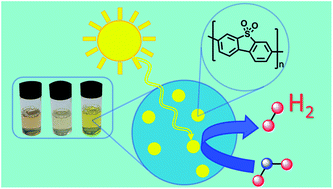Emulsion polymerization derived organic photocatalysts for improved light-driven hydrogen evolution†
Abstract
Here, we present the use of mini-emulsion polymerization to generate small particle analogues of three insoluble conjugated polymer photocatalysts. These materials show hydrogen evolution rates with a sacrificial donor under broadband illumination that are between two and three times higher than the corresponding bulk polymers. The most active emulsion particles displayed a hydrogen evolution rate of 60.6 mmol h−1 g−1 under visible light (λ > 420 nm), which is the highest reported rate for an organic polymer. More importantly, the emulsion particles display far better catalytic lifetimes than previous polymer nanoparticles and they are also effective at high concentrations, allowing external quantum efficiencies as high as 20.4% at 420 nm. A limited degree of aggregation of the polymer particles maximizes the photocatalytic activity, possibly because of light scattering and enhanced light absorption.



 Please wait while we load your content...
Please wait while we load your content...